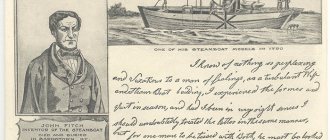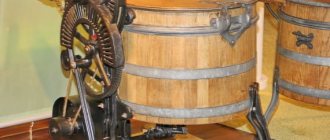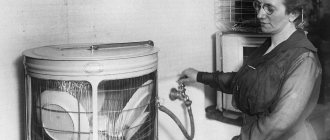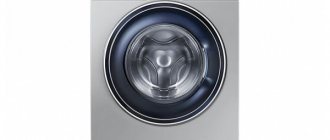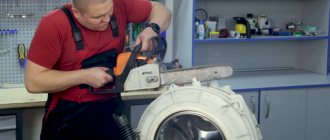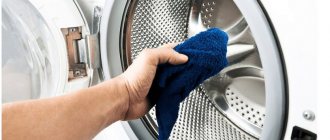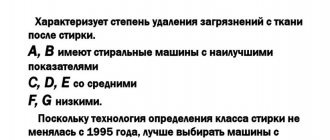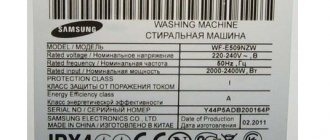An automatic washing machine is rightfully considered one of the best achievements and technical developments. Today she is desired in every family. People like these household appliances, which make the washing process as easy as possible. Its advantages include saving not only time, but also effort. And the history of the washing machine, equipped with an electric drive, began a long time ago .
Creation of the first washing machine
Previously, it took women half a day to do laundry, and if the family was large, the process could last a whole day. The creator of the first washing machine is James King from America, who patented his invention in 1851 . In shape it was very similar to its modern counterpart, but at the same time it had a significant difference - manual drive. If you need your washing machine repaired at home, contact our company; the company’s technicians will do it as quickly and efficiently as possible.
With the advent of the first washing machine, many similar inventions were invented. Some were not full-fledged working mechanisms. Among them there were also devices that were worthy of attention. For example: an American from California developed a device that could wash 10 to 15 shirts or T-shirts at once. True, it was necessary to harness 10 mules to it, but the man himself did not make any effort.
To wash clothes in this way, you had to pay the inventor a certain amount of money. This is how the world's first public laundry appeared. No special care was required. It was enough to feed the mules on time.
It is impossible not to mention the unusual American museum. It is located in Eaton, Colorado. The owner of the museum, whose name is Lee Maxwell, has been collecting washing machines produced at the beginning of the 20th century for many years. There are 600 devices in the collection. Most were restored and brought into working order.
Battle without masks
And, of course, with such a scale it will be easier to produce ourselves than to buy. Since there will be nothing to buy with, export volumes from all countries will decline sharply. C'est la vie, there's no escape! And, accordingly, the main economic question: what will the structure of the economy look like, what will they buy, what will need to be produced! And, of course, the price structure! And here it turns out that the Khazin Foundation has been dealing with these issues for 5 years, but everyone else has not... However, this is another topic.
Source
The first washing machine, mass production
Inventor William Blackstone was the first person to mass produce washing machines. He gave the first design to his wife for her birthday. And after that he began selling washing machines at a price of $2.5 per unit . The industrial enterprise that was founded by Blackstone continues to operate today, delighting consumers with its products.
Washing machines with a motor in their design
A real breakthrough was the use of motors in washing machines. First, an internal combustion engine was used, and then an electric motor.
In Europe, washing machines appeared on the household appliance market in 1900. For the first time their production was established here in Germany. The washing machine was constantly improved, and in 1908, inventors managed to design an electrically driven washing machine, thanks to the use of the latest technology. The inventor of the Thor machine, Alva Fischer, is known to history as the creator of a new generation of electrically driven household appliances.
Washing in ancient times
It is not known for certain when exactly people learned to wash dirt from clothes with water. But this happened, of course, quite a long time ago. Primitive people, of course, hardly did laundry. However, historians were able to find out that a mixture of fats and alkalis, intended to remove dirt from clothes, was made more than 5 thousand years ago in ancient Sumer and Babylon.
Creation of the first automatic washing machines
Mechanization led to the fact that the laundress profession became unnecessary. When washing machines appeared on the market at the beginning of the 20th century, many families were soon able to purchase this wonderful piece of equipment for their home. Public laundries began to close everywhere, as their services were no longer in demand. In addition, the boom in washing machines was followed by mass layoffs or reductions in domestic workers. The mechanization of labor at an affordable price was able to quickly displace human labor. The first automatic washing machine appeared in 1947. Two American companies participated in its invention: Bendix Corporation, General Electric.
Their products appeared on the market almost simultaneously. Over the next decade, the vast majority of washing machine companies also introduced automatic models of household appliances.
In the 20th century, production continued to modernize and expand. By 1920, there were approximately 1,400 companies in the United States that produced popular products. It should be noted that many only cared about ensuring that washing machines performed only their basic functions. Parts and drives were often left exposed. Such manufacturers could not provide any guarantee of safety to their consumers. At that time, a real revolutionary revolution was made by an unknown company called Whirpool.
Competent designers hired on staff close the washing machine using plastic covers. They manage to reduce noise. The color range has been expanded. The terrible, clumsy apparatus has sunk into oblivion. It was replaced by a rather stylish electric household appliance. Soon, competing companies followed the example of Whirpool: now the improvement of the machine concerned not only its technical side, but also its attractive appearance.
The first Soviet automatic washing machine
"Volga 10"
This creation appeared back in 1975. The washing machine was given the name “Volga 10”. It was assembled at the plant named after. V.I. Chapaev in Cheboksary. However, the device was discontinued in 1977, since the apartments did not have the electrical wiring required to operate the machine.
Another model called “Vyatka-automatic-12” turned out to be much more successful, the release date of which is considered to be 02/21 – 1981. The machine-building plant in the city of Kirov bought a license from the European company Merloni Progeti (Italy). Today this company is known to consumers all over the world as Indesit. The device was equipped with Italian equipment and a new housing. The model was a copy of the Ariston washing machine.
A brief excursion into the history of the last two centuries
XX century
20s - enamelled steel tanks replace wooden tanks lined with sheet copper.
30s - washing machines are equipped with mechanical timers and drain pumps with an electric motor.
40s - a special software device for washing machines is created. The first automatic washing machine is produced in the USA.
50s - machines with a centrifugation function appear. The first automatic washing machine was produced in Europe.
70s - a washing machine with a microprocessor control system is created.
90s - machines are developed that operate according to FuzzyLogic principles, which makes it possible to significantly expand the capabilities of household appliances and implement a large number of washing programs.
XXI century
The beginning of the 21st century - it became possible to integrate washing machines into the intra-apartment network of household appliances of the “intelligent home”. To control the devices, it is enough to have access to the Internet.
Her time has just passed
The Soviet mini-washing machine began to lose its conquered positions only in the “roaring nineties”, when a flow of foreign household appliances of a new generation poured into the country.
— The main problem was that “Malyutka” does not have any automation. Modern housewives are accustomed to selecting different washing modes by pressing a couple of buttons, but with this mini-washer everything is very simple: turn it on and off. One mode for everything. Plus, there is no spin, for example. In general, her time has simply ended,” says Sergei Ageev.
By 1996, the release of “Malyutok” dropped to one and a half thousand per month, and soon stopped altogether. But many housewives still remember these machines with warmth. Although it was necessary to place boards under the mini-washer so that it did not vibrate too much, and the sheets sometimes tore during washing, it was still a light, trouble-free and cheap machine (38 rubles in “pre-perestroika” prices) in the seventies and eighties of the last century greatly helped out many millions of Russian families.
Article on the topic: How to disassemble a Philips Expression vacuum cleaner
Opinions
Evgeny Roizman, mayor of Yekaterinburg (LJ entry):
“This “Baby” brought so much joy to people! Every family had it. Our mothers did most of the washing by hand. Do you remember when there were still troughs like this? They rested the washboard there and rubbed it, washing their hands. And suddenly - “Baby”! And we do it ourselves. Who wouldn't be happy?
Rudolf Grashin, OG journalist:
— “Malyutka” was with us during our student years. Then almost every evening I had to wash baby diapers and nappies (there were no disposable diapers at that time). There was always not enough time, it was necessary to wash quickly... The Malyutka did not have any washing program - the machine was turned on and off with a toggle switch. Now this looks like a disadvantage, but for us then it was a plus, since it allowed us to greatly speed up the whole process. The water after washing and rinsing could be poured into the bathroom at once, simply by turning the machine over. Washing went quickly and usually took only half an hour. If the machine had a program, then probably only one cycle would take so much time. Why wash diapers for 30 minutes?
Plot
“Legendary Sverdlovsk brands” The Sverdlovsk region produced both excellent food products and high-quality consumer goods. To remember them and believe in ourselves, in the fact that we can do a lot ourselves, is the goal of this series of publications.
The laundry was invented by a gold miner
Technical progress, as we found out, was rapidly gaining momentum by the end of the 19th century. In 1877, the number of patents for “devices for facilitating washing” in the United States alone exceeded two thousand!
True, not all inventions received a “start in life.” For example, there were machines that could wash only one sweat-soaked shirt in one cycle. Such ideas “did not go through the competition.”
Back in 1850, a machine appeared in California that could wash 12 shirts at once. It was invented by gold miners - who definitely needed a lot of laundry and almost every day!
The California miracle machine was in such demand that its inventor began to make money “at retail” - on every wash, receiving gold sand and even nuggets from miners. And the first laundry in the Klondike operated on the traction force of ten10 harnessed mules.
This is how the first paid laundry in history appeared - the Laundromat. This service turned out to be in great demand thanks to the working bachelors gathered in densely populated communities. And even now the “electoral base” of today’s laundries is stevedores, sailors and, of course, gold miners.
Of course, the inventors could not limit themselves to making washing easier. There were a lot of related tasks: for example, spinning, drying and ironing. By the way, the extraction of water from washed clothes was mechanized in 1860 - with the help of hand rollers - they were a mandatory attribute of every washing machine for almost one hundred and fifty years. Even nowadays they can be found in the simplest “semi-automatic machines”.
Modern SMA
In modern models, discrete logic has been replaced by Fuzzy Logic (read more about it in the corresponding article). Its distinctive feature is the mass of parameters that the user can set, as well as information that is read by sensors and reported to the control unit.
In the latest developments, Fuzzy Logic has been replaced by UseLogic - the system analyzes all parameters of the laundry, determining the optimal washing process. During the mode itself, processes are analyzed, examined and adjusted - this reduces the consumption of resources and detergents. At the same time, the quality of washing and the impeccable appearance of the laundry are maintained.
Clear Water sensor is a development that analyzes water contamination. If the sensor tells the board that the water is too cloudy, the system will automatically initiate an additional rinse.
We can discuss the cars of our time endlessly, but this is a topic for a separate article. And you have already learned the most interesting things about the history of the emergence and development of this industry.
Source
Rating for housewives
As for the USSR, development also took place there, although not on such a scale. So, until the beginning of 1925, the population was not at all familiar with such equipment, but they began to purchase it from foreign companies for nomenklatura workers.
There was still a choice of washing machines in the USSR, but mostly these were the prototypes of “Miele” and “Husqvarna”, which are known as “Vyatka” and “Riga”.
When the Second World War ended, industry began to recover in the country and the leadership did not ignore developments in this area. Thus, several enterprises appeared that produced semi-automatic devices.
16 years have passed and the Kirov plant also began producing analogues called “Vyatka”. They had almost no differences from the proposals of the Riga enterprise - with the same round tanks into which water was poured with a bucket. The first Vyatka produced had one advantage - a mechanism of two squeezing rollers was attached to it.
But already in the 70s the situation improved significantly, as even more enterprises joined the production. As a rule, in any city with a population of more than a million people there was a factory for the production of typewriters. This allowed people to see the Chaika, Volna, Volga, Kyiv and many others models in stores.
However, they differed from each other only in name, since they were strikingly similar. The only advantage turned out to be an impressive service life - even today some farms use them, despite their age of 40 or 50 years.
I work in the household appliance repair industry. Extensive experience in restoring washing machines and dishwashers.
Further, after the collapse of the USSR, foreign corporations began to build factories in post-Soviet countries to produce products for the domestic market. Their quality and cost turned out to be appropriate. Therefore, consumers still prefer models assembled in Europe or Asia.
